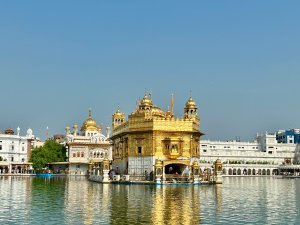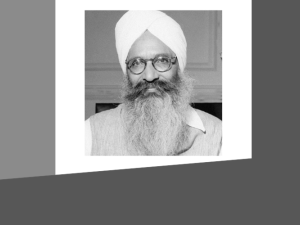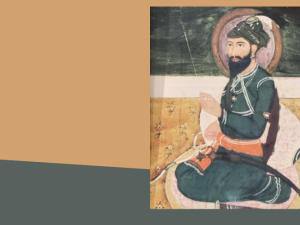Much has been written about Giani Zail Singh’s role in bringing Sant Jamail Singh Bhindranwale on the centre stage of Sikh politics. Consequently, people have come to believe that Bhindrawale was propped up by Giani Zail Singh to beat the Akalis in the politics of one man up ship. Political analysts wrote that Bhindrawale proved a Frankstein for the Congress for whose benefit he was allegedly brought to the fore by Giani. Emergence of Sant on the map of Punjab, his fight with Akalis, his taking part in SGPC elections, his open support to Congress in Parliament and State elections in 1980, his free movement with gun carrying followers in the whole of India, his safe escape from Chando Kalan in Haryana in 1981, his release after interrogation on the charges of murder of Lala Jagat Narain, (Editor Hind Samachar) his entry into Golden Temple complex and many other such events are interpreted as political maneuverings of Giani Zail Singh. Above all, some quarters charge Giani of even intimating Bhindranwale in advance the Government plan to send army into the holy precincts.
Both Giani Zail Singh and Sant Bhindranwale are no more, and cannot give answers to all these questions. Mark Tully and Satish Jacob in their book, “Amritsar: Mrs. Gandhi’s Last Battle,” mentioned all the above charges. I wrote to Mark Tully asking him to prove any of those. In reply, he sent me a photograph of Giani with Bhindranwale sitting side by side. I wrote to him, that this was taken in a memorial congregation held in Delhi soon after the assassination of Jathedar Santokh Singh in 1981, which was attended by both.
Here I take the liberty to lay-bare some hard facts known to me so that this myth about Zail Singh-Bhindranwale ‘coziness’ can be examined without any malice. Bhindranwale belonged to a religious seminary tracing its origin to the times of Guru Gobind Singh Ji and Baba Deep Singh. At young age Jarnail Singh succeeded Sant Kartar Singh, who led Damdami Taksal. He had both zeal and enthusiasm along with dedication to prove equal to the task. He soon became popular among the Sikhs as a competent exponent of the Sikh scriptures. He was always on the move having his headquarter at Mehta Chowk in District Amritsar. The vehicle in which he travelled was usually full of students of the Taksal I attended many congregations addressed by Sant Ji at Gurdwara Dukhniwaran Patiala. A tall handsome person having great fluency in Punjabi soon proved a hit with devotees. From the very beginning he carried a revolver on his person alongwith a small Kirpan and an arrow in his hand and became popular with the Sikh multitude. In huge congregations that gathered to listen to him, he used to preach austere living, simple marriages, abstinence from all types of intoxicants and strict observance of the Code of Conduct of the Khalsa.
It was matter of coincidence that at the time he appeared on the scene, the Akali Party came back into power in 1977 with Sardar Parkash Singh Badal as Chief Minister. Akalis were in coalition with Jana Sangh and Janta dal. Even Romesh Chander (Hind Samachar) an MLA was supporting the Government. Sant Jarnail Singh did not like this opportunists alliance. He was dead against all those elements who had opposed Punjabi language and the formation of Punjabi Suba. He maintained no contact with the Akali leadership as a whole except Gurcharan Singh Tohra, the then President of the SGPC.
It was on 6th April, 1978 that the formation of a new party called Dal Khalsa was announced in a meeting held by a Punjab University employee, Harsimrat Singh in the Aroma Hotel at Chandigarh. Incidentally, when this press meet was being held, Giani Zail Singh was also present in the same Hotel to attend some other function. It is alleged that he paid the bill for their press conference. Dal Khalsa emerged as an independent group of young educated Sikhs. It is, perhaps, a coincidence that only a week after Dal Khalsa was launched, a tragic event shook the entire State. On 19th April, 1978 the Sant Nirankari Mandal organized a big Samagam in an open ground at Amritsar. Baba Gurbachan Singh the head of the sect. was present there. Sikh groups had since long been condemning them for their wrongful use of Sikh terminology and some unsavoury remarks in their religious book ‘Avtar Bani’. Akhand Kirtani Jatha opposed their meet at Amritsar. While this congregation was in progress, a small Jatha led by Fauja Singh marched to the place. The Nirankaris on their part seemed to have been well prepared to face them and attacked these unarmed demonstrators as soon as they reached near their Pandal. Eighteen persons were killed. Bhindranwale was present in Manji Sahib where this Jatha had decided to protest at Nirankaris samagam. After the tragedy, Sant appeared at the centre-stage and with his typical style; put the Akali Janata Coalition government on the defensive for allowing this Samagam in the holy city. S. Prakash Singh Badal was at that time in Bombay for Baisakhi Day. Jathedar Jagdev Singh Talwandi and I were also with him. As soon as he learnt about this, he rushed back to Punjab. He allowed safe exit of Baba Gurbachan Singh from the Punjab territory, which was highly resented by the Sikhs. Bhindranwale described the Nirankaris as Narkdharis and took a vow to avenge the killings. Baba Gubachan Singh was later shot dead in his own house in Delhi in April 1981 Bhai Ranjit Singh who was subsequently appointed, as Jathedar of Akal Takht was named as the main accused. Meanwhile, Bhai Amrik Singh a close aide of Bhindranwale and son of Sant Kartar Singh, was elected as President of All India Sikh Students Federation. These three happenings, founding of Dal Khalsa, killing of devout Sikhs at Amritsar and election of Amrik Singh as head of A.I S.S. F. paved the way for Bhindranwale to emerge in a new role. Any student if history can, make his/her own assessment of the sudden rise of Bhindranwale. I hold the opinion that it was a natural result of the prevailing situation in Punjab at that time.
Bhindranwale toured all over the Punjab and went on accusing the Punjab Government for having a soft corner for the Nirankaris. He wanted the arrest of Baba Gurbachan Singh as the main accused for the brutal killings of innocent devout Sikhs who marched for protest towards the Nirankari Samagam. The Punjab Government at that time did not take any step to satisfy or pacify the injured feelings of the Sikhs. This provided a golden opportunity to Bhindranwale for entry into Sikh political arena. He openly started propagating that there are forces within the Central as well as State Government that are out to harm the Sikhs.
There was a bye-election of Baba Bakala seat of the SGPC in 1978 and the Akalis put up Jathedar Jiwan Singh Umra Nangal a Minister in the Government. Bhindranwale immediately announced’ the candidature of Bhai Amrik Singh. This became a scene of Bhindranwale Vs the Akalis. The Congress which was then out of power got a chance to enthuse their workers and decided to support Bhindranwale’s candidate. But the emergency stigma on them was so severe that they could not muster any support. Moreover, the combined pressure of Punjab Ministers and SGPC managed victory of Umra-Nangal, a maverick of Akalis party.
During the General Election of SGPC in 1979, the Congress party decided to embarrass the Akalis. Sanjay Gandhi was advised by his friend Vishwajit Singh to take advantage of Bhindranwale’s rift with Akalis in order to destabilize the Akali government. A meeting was called and services of S. Gurbir Singh, son of the late justice Gurnam Singh were commissioned. Vishwajit and Gurbir Singh (Baku) were provided monetary support and they remained very active. They had meetings with Bhai Amrik Singh and promised him full support. Bhindranwale was keen to oppose the Akalis and he put up a number of candidates in SGPC elections. Sanjay Gandhi gave instructions to all Congress leaders especially Giani Zail Singh, S. Darbara Singh and Dr. Gurdail Singh Dhilion to help the Bhndranwale group. Despite all this, the Aklais won the elections hands down and only six candidates put up by Bhindranwale could be elected.
Emergency was lifted in 1979 and Parliamentary elections were called in the month of December. R.L. Bhatia, the Congress candidate from Amritsar got support of the Bhindranwale Group, as they were opposed to the Akali party. As I understand, bitterness between Sant Jarnail Singh and the Akalis was a major cause of the their opposing Akalis at that time. The Akalis were supporting another group of Damdami Taksal headed by Giani Mohan Singh.
The Congress won the Parliamentary elections and Indira Gandhi returned as Prime Minister, in January 1980. Giani Zail Singh joined the Central Cabinet as Home Minister. He always supported the policy of conciliation. He managed and helped Ch. Bhajan lal, Janta Dal Chief Minister, Haryana, to join the Congress Party. In Punjab, he advocated some partnership agreement between the Akalis and the Congress, but did not meet with success there. The Punjab Ministry was dismissed and in the fresh elections Congress Party won with a big margin. Darbara Singh, President of the Punjab Congress was installed as Chief Minister. He was deadly opposed to Giani. He did not believe in Giani brand of politics of conciliation. In April 1980, Baba Gubachan Singh, Nirankari Chief was shot dead at his home in Delhi. At once, the press linked Bhindranwale’s name with his murder. On the basis of investigation reports supplied by the State and Central agencies, Giani Zail Singh informed the Parliament that Bhindranwale was not involved in the murder of the Nirankari Chief. This was treated as Giani’s soft peddling towards Bhindranwale.
I need not give details of all events during 1980-81 of Bhindranwale’s ascendance to the political horizon of the Punjab. From a religious preacher he became a social crusader and a political ideologue. Media gave Sant Jarnail Singh special attention. He was frequently interviewed by the press correspondents and photographers. Killing of Lala Jagat Narian on September 9, 1981 was a turning point in Punjab crisis. Bhindranwale’s name was linked with his murder. His arrest from his headquarters became an extra-ordinary event. Sikhs gathered there in large numbers for protest and eleven people were killed by the police firing at Chowk Mehta after Bhindrawale’s arrest. After some time he had to be released by Punjab Police for lack of evidence. Giani had no role to play in this Punjab State affair. Earlier when the Punjab Police went to arrest him at Chando Kalan (Haryana) he escaped. Even then some people accused Giani of having leaked the information regarding the raid. Rumours which became afloat, blamed Giani for making a hero of Sant, ignoring the fact that Punjab Police under directions of the Government carried out the operation. In the process, the Sant won sympathizers and admirers in the Services and Police.
Jathedar Santokh Singh was shot dead on 21 December 1981. He was a friend of Bhindranwale and close of Indira Gandhi. Bhindranwale attended his Bhog ceremony, which took place in Delhi. Giani also attended the function. I accompanied him. Sant Bhindranwale was sitting in the front row and Giani was also seated there. Not a word was exchanged between them. Soon after the Bhog the Giani left. Photographs of both sitting together were published in the newspapers. On the way back, Giani told me that he had personally seen Bhindranwale for the first time. I particularly asked him “everyone believes that you have promoted him in politics and how come you did not meet him earlier?” ‘He told me that it was all a’ canard spread by Darbara Singh in order to malign him in the eyes of the Congress High Command. He said, in 1978 there could have been a chance meeting when both were invited to a function at Baba Bakala. Giani left the place after his speech before Bhindranwale could arrived there. But he said on his own that he sincerely desired Bhindranwale to confine himself to religious and social spheres. He admitted that the Sant had a large following among the Sikhs and his influence and energy could be utilized for the good of the State and the community. He was sure, Darbara Singh could spoil the political atmosphere and Punjab would suffer a lot.
Bhindranwale stayed in Delhi for some time and later went to Bombay. A horde of his followers were with him. A question is often asked why was he allowed to move freely. Zail Singh would say that there was no case against him and also no ban on his movements. All the guns his followers carried were licensed and if there was any violation of law, the State Governments had full authority to take action.
Giani Zail Singh became President of India on 26th July 1982. He was strictly advised by Indira Gandhi to keep himself aloof from the Punjab and the Sikh affairs. What happened after the period is well known. He had no role to play at any point of time. He was kept in the dark by all official agencies. He mentioned this fact to every leader from Punjab who came to see him. In fact he was a victim of a vilification campaign let loose against him by his detractors and political opponents. They convinced the media that Bhindranwale was his creation. The Sikhs at large were most happy with a devout Sikh in the Rashtrapati Bhawan but Army attack on Akal Takht left a lifelong blot on him because people could not be convinced that he had no role in this.
It is a pity that both Giani ji and Sant Bhindranwale were maligned with ulterior motives. I need not analyze the role of Bhindranwale during the crucial period of 1983-1984, or the circumstances which led to the uncalled for Army attack on the Golden Temple and the ultimate sacrifice of Sant Bhindranwale on June 6, 1984.
TARLOCHAN SINGH
EX-MP
SikhNet is honored that Sardar Tarlochan Singh ji, EX-MP, Former Chairman National Commission Minorities, India is sharing his personal recollection of historical events with our audience.
The opinions expressed here are personal to the author and do not necessarily reflect an editorial position of the SikhNet staff or board.






